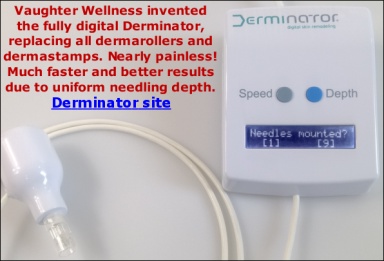1. Kind of silly to ask - but what exactly is the vitamin C good for (besides reducing pigmentation) ?Can it help thicken thin skin? Is it safe to use under the eyes?
Collagen is the skin's main protein, produced by fibroblasts. Vit. C is necessary for collagen synthesis.
Vit. C is a potent antioxidant, it protects the skin from oxidative damage and thus partially prevents photoaging.
The human body does not produce vit. C itself. Primates and Guinea pigs are the only mammals that need to get their vit. C from food. The oral intake would have to be extremely high to achieve high levels of vit. C in the skin. That is why it is very beneficial to apply vit. C topically.
Yes it is safe to apply it under the eyes. Avoid getting it into the eyes though. If you do by mistake, just rinse it.
Vit. C doesn’t thicken the skin by itself, but it stimulates collagen production. The skin under the eyes naturally has very little fat and the fat is further receding with age. Receding fat cannot be fixed by vit. C or dermarolling nevertheless vit. C rejuvenates the skin. There are many studies concerning vit. C's rejuvenating effects. Just two examples:
Topical ascorbic acid on photoaged skin. Clinical, topographical and ultrastructural evaluation: double-blind study vs. placebo.
Humbert PG, Haftek M, Creidi P, Lapière C, Nusgens B, Richard A, Schmitt D, Rougier A, Zahouani H.
Department of Dermatology, Hospital Saint Jacques, University of Franche-Comté, Besançon, France.
RESULTS: A highly significant increase in the density of skin microrelief and a decrease of the deep furrows were demonstrated. Ultrastructural evidence of the elastic tissue repair was also obtained and well corroborated the favorable results of the clinical and skin surface examinations. Topical application of 5% vitamin C cream was an effective and well-tolerated treatment. It led to a clinically apparent improvement of the photodamaged skin and induced modifications of skin relief and ultrastructure, suggesting a positive influence of topical vitamin C on parameters characteristic for sun-induced skin ageing.
Use of topical ascorbic acid and its effects on photodamaged skin topography.
Traikovich
Beeson Aesthetic Surgery Institute, Carmel, Ind., USA.
RESULTS: Clinical assessment demonstrated significant improvement with active treatment greater than control for fine wrinkling, tactile roughness, coarse rhytids, skin laxity/tone, sallowness/yellowing, and overall features. Patient questionnaire results demonstrated statistically significant improvement overall, active treatment 84.2% greater than control. Photographic assessment demonstrated significant improvement, active treatment 57.9% greater than control.
2. Should I be applying it along while dermarolling (it stings) or is it also useful for everyday use?
It is useful for everyday use. Although regular application every other or third day is sufficient. Vit. C stays in the skin for several days.The half-life of vit. C in the skin is about four days. (The amount of vit. C present in the skin will halve every four days.)
Do not apply vit. C directly after rolling with long-needled rollers ( > 0.5 mm ). It will sting and burn the skin. Apply it the days prior to rolling to achieve maximum concentrations and re-continue applying the day or two days after rolling.
You can try to apply vit. C directly after rolling with short needled rollers for skin care product penetration enhancement. If it stings too much ( vit. C is an acid), add more water to the serum. If it irritates the skin too much, do not apply it immediately after rolling.
3. Mixing the vitamin C solely with water makes a too thin solution (watery). Is it possible to mix it up with some glycerine ?If so, what is the best ratio for vit. C/ dilluted water / Glycerine?
Vit. C has to be very low pH to be absorbed to the skin. Anything you add to it can change the pH and other characteristics. That is why I do not recommend mixing it with anything. You can do that but you cannot be sure whether it affects its absorption or not.
If you apply vit. C after rolling with short-needled rollers for products penetration, there will be high skin penetration. The downside is that it stings and in some sensitive individuals it may cause irritation.
Applying it with aloe gel or glycerin is certainly better than not applying it at all. Its absorption might not be compromised at all when mixed with something. It was just never studied so we do not know. There are studies about the absorption of ascorbic acid dissolved in water and only when its pH was very low, it got absorbed into the skin.





